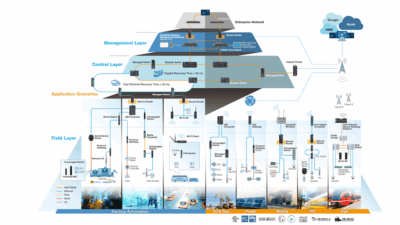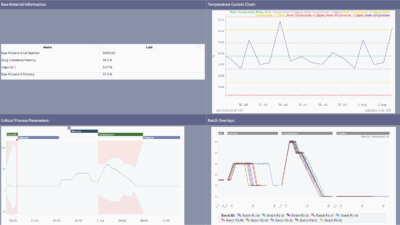Six industry experts address interoperability, cybersecurity and latency concerns, including the emerging industrial network technologies that may solve some problems for automation, control system applications. Get industrial networking answers from this Control Engineering expert roundtable.

Industrial Network trends and insights:
- Understand technologies, trends and challenges identified by industrial network subject matter experts in a Control Engineering roundtable discussion.
- Explore questions and answers on industrial networking technology trends for control systems and automation applications.
- Learn about emerging technologies and the biggest issues impacting industrial networks.
Control Engineering asked six experts in industrial networking to answer questions about the challenges, trends and technologies that enable communication among systems on the factory floor for automation and control system applications. Issues that are top of mind include interoperability, cybersecurity and standards.
Answering questions on industrial networking topics in a roundtable format are:
Dr. Al Beydoun, president and executive director, ODVA
Michael Bowne, executive director, PI North America
Tom Burke, global strategic advisor, CC Link Partner Association (CLPA)
Felipe Costa, senior networking and cybersecurity product manager, Moxa
Chris Liu, industrial edge product marketing manager, Siemens
Robert Trask, PE, North American representative, EtherCAT Technology Group
The following questions and answers address a variety of topics related to industrial networking.
What’s the biggest issue impacting industrial networks in today’s manufacturing facility?
Tom Burke: One of the biggest issues impacting industrial networks in today’s manufacturing facilities is interoperability across heterogeneous systems—particularly the challenge of integrating legacy equipment with modern, smart factory technologies.
Interoperability is very important. I’ve been preaching about OPC UA interoperability since the OPC Foundation first developed the OPC UA technology. Industrial networks in today’s manufacturing facilities have a lot of different disparate devices and different disparate networks.
Some of the challenges are caused by:
- Protocol fragmentation: Many facilities run equipment from multiple vendors, each using different industrial communication protocols (e.g., EtherNet/IP, Profinet, Modbus, CC-Link IE). This makes seamless data exchange difficult without custom middleware or protocol gateways.
- Lack of unified standards: Although standards like OPC UA and Time-Sensitive Networking (TSN) aim to unify communication, adoption is inconsistent. Full convergence remains a work in progress. This limits scalability and adds complexity when connecting operational technology (OT) to information technology (IT) systems.
- Cybersecurity risks: As networks become more connected (e.g., through the industrial internet of things (IIoT) and remote access), they become more vulnerable. Older systems weren’t designed with cybersecurity in mind and retrofitting them is costly and technically difficult.
- Data silos and latency: Without real-time, deterministic communication across devices, manufacturers struggle to get timely insights for predictive maintenance, quality control and optimization.

Al Beydoun: One of the biggest issues impacting industrial networks today is cyberattacks. This is one of the reasons that the European Union (EU) has passed the Cyber Resilience Act (CRA) to help protect devices. Common Industrial Protocol (CIP) Security, the EtherNet/IP cybersecurity network extension, offers confidentiality, integrity, authentication and non-repudiation. The implementation of CIP Security involves device identity management, secure communication protocols and vulnerability mitigation, which are essential for compliance with the EU CRA.
Robert Trask: The biggest issue today is certainly cybersecurity, and security threats to industrial applications are going to increase. With this in mind, you need to ask if you really want an Internet Protocol (IP) routed network at the OT level. There are options that are not IP routed and have inherent cybersecurity benefits, such as EtherCAT which is Ethernet-based, but not IP-based. EtherCAT networks don’t require switches, and EtherCAT devices do not have IP addresses.
Since almost all cyberattacks require the IP for routing, they go nowhere with EtherCAT. EtherCAT chips filter out non-EtherCAT frames in hardware, and EtherCAT devices can’t be tricked into falsifying data not intended for them, even by compromised firmware. Also, EtherCAT ports that are not used can be switched off for added security.
If cybersecurity is a big issue, what are the most critical risks for industrial networks?
Felipe Costa: The top risks include unauthorized access, unpatched devices, weak segmentation and lack of visibility. Threat actors exploit legacy protocols and flat networks. That’s why frameworks like IEC 62443 [Security for Industrial Automation and Control Systems], combined with asset visibility and intrusion detection, are critical.
Chris Liu: The leading cybersecurity risks are malware, ransomware, data breaches, network segmentation and IIoT device security issues.
Beydoun: Encryption via transport layer security (TLS)/datagram transport layer security (DTLS) is a crucial cybersecurity protection in case sensitive message traffic, such as product recipes, are intercepted and/or exfiltrated from an internal network. End point authentication via X.509 certificates is another valuable cybersecurity method that ensures that devices are authorized to communicate and send commands.
It’s also important to verify that messages between devices haven’t been intercepted and altered. Data integrity and message authenticity can be accomplished via Keyed-Hashed Message Authentication Code (HMAC). Industrial Ethernet networks such as EtherNet/IP rely on cybersecurity protection from CIP Security that includes encryption, authentication, integrity, authenticity and other protections to help mitigate critical cybersecurity risks such as malware and ransomware.
What are the key differences between fieldbus networks (Profibus, Modbus, DeviceNet, etc.) and Industrial Ethernet?
Michael Bowne: The principal difference between legacy fieldbus networks and industrial Ethernet protocols is the physical layer. Legacy fieldbuses used serial communications like RS-485, whereas today’s networks are Ethernet-based. While this sounds trivial enough, the step change is as significant as going from analog to digital communications. The breadth and depth of capabilities of Ethernet are matched only by its widespread familiarity.
Beydoun: Fieldbus networks were primarily designed to connect controllers to sensors and actuators for OT applications. The main benefits are real time control and determinism, as well as additional speed and diagnostics compared to hardwired systems. However, flexibility is often limited by hardware being tied to the communication protocols. Ethernet networks were built with more expansive architectures in mind, including IT integration, and come with the benefits of additional speed and bandwidth compared to fieldbus networks. To support real time communication, methods such as the IEEE Precision Time Protocol, used by the EtherNet/IP network extension CIP Motion, and IEC/IEEE 60802 Time Sensitive Networking (TSN) are utilized. However, the significantly increased bandwidth offered by industrial Ethernet networks is satisfactory for most applications and has solved previous concerns about speed.

Burke: This is fairly simple to understand if you think about how the industrial Ethernet is faster, more scalable and supports more complex real-time and IT-ready applications. The legacy field systems are still found in many plants but are being replaced by Ethernet- based solutions and many of the fieldbus networks have Ethernet-based succession plans.
The fieldbus networks really are more relevant today as legacy systems in comparison to the industrial Ethernet networks. The biggest advantage of the industrial Ethernet is far more reliability and performance. As we want to really get a lot more data and convert that data into useful information, having high speed performance that the industrial Ethernet provides is required.
The fieldbus networks are well adopted into the marketplace, and there’s a huge advantage of the fieldbus networks because of the multitude of industrial devices that support the various fieldbus networks. But the industrial Ethernet is gaining a lot of traction, and we will see a lot of devices that will be on the industrial Ethernet that mirror the number of devices that are available on the fieldbus networks. TSN technology (geared towards the industrial Ethernet) will not be the type of network that a fieldbus network will coexist on. There are a lot of opportunities with respect to bridges and gateways that allow the fieldbus networks and the industrial Ethernet to work together.
Costa: Fieldbus systems were designed for deterministic, isolated control with low bandwidth. By contrast, industrial Ethernet enables scalable, high-speed and flexible communication, supporting real-time protocols like Profinet and EtherNet/IP while enabling better integration with enterprise systems.
Trask: The biggest difference between legacy fieldbuses and modern industrial Ethernet is a less expensive communication architecture. Industrial Ethernet is sadly not always “faster” or less engineering effort, so your mileage will vary depending on which network you choose. The multi-protocol industrial Ethernet world is vast and has completely dominated the current fieldbus landscape. But, as mentioned before, we have to be careful with the notion of the IT/OT convergence. Implementing an IP routed and switched fieldbus network can be dangerous, but those hazards can be completely avoided with EtherCAT.
How are industrial networking technologies evolving to enable fast and reliable data exchange in an era of digital transformation?
Liu: Here are a few examples of industrial networking technology evolution:
1. Using edge computing technology, which brings data processing, analysis and storage closer to data sources, enables secure, fast and efficient data exchange.
2. Digital twin technology enhances data exchange by providing a comprehensive view of operations, fueling real-time monitoring, predictive maintenance and advanced process control.
3. Adoption of IoT protocols, such as MQTT, that are lightweight and efficient makes data exchange more reliable in environments where bandwidth is limited.
Bowne: The trick in industrial networks has always been about ensuring operation while mining the application for non-control related data. OT networks exist in environments that abhor unplanned downtime. Enabling access to non-control related data at the expense of control related data is unacceptable. Therefore, care should be taken when selecting an industrial Ethernet protocol – ideally combining high performance with openness.

Costa: We’re seeing a move toward deterministic Ethernet, TSN, edge computing and AI-based monitoring. These technologies facilitate reliable and secure flow of data across complex environments, supporting real-time decisions and predictive maintenance at scale.
Burke: Industrial networking technologies are evolving rapidly to meet the demands of digital transformation, with a focus on speed, reliability, scalability and seamless integration across IT and OT systems. Here are the key ways this industrial network evolution is taking place:
Migration to industrial Ethernet:
- From fieldbus to Ethernet-based protocols like Profinet, EtherNet/IP, EtherCAT, and TSN (Time-Sensitive Networking) and CC-Link IE TSN.
- Higher speeds (up to 1 Gbps+), deterministic communication, and integration with IT systems, such as cloud, manufacturing execution systems (MES) and enterprise resource planning (ERP) systems.
Adoption of TSN:
- Provides real-time, deterministic Ethernet communication.
- Enables multiple traffic types (such as real-time control, diagnostics, video) to coexist on one network.
- Foundational for converged IT/OT networks.
- CC-Link IE TSN is the major network that has added TSN technology to the product portfolio enabling the ability to have multiple protocols running on the same physical wire. This ability to coexist on the same physical wire provides seamless interoperability, enabling the digital transformation.
Emphasis on interoperability and open standards:
- Use of OPC UA, Pub/Sub, and companion specifications for vendor-neutral, secure data exchange.
- Supports plug-and-play integration, digital twins and harmonized data models.
- The value proposition of open standards really is the strategy for customers to be able to use multiple network protocols and connect all devices to gather data that can be transformed into useful information.
Edge computing integration:
- Edge devices now perform local analytics and control, reducing latency and bandwidth usage.
- Networking must support bi-directional data flow between edge, cloud and machines.
Increased use of Single Pair Ethernet (SPE):
- Extends Ethernet to the last mile (sensors, actuators) with long cable lengths and compact form factor.
- Bridges the gap between legacy field devices and modern Ethernet-based systems.
Cybersecurity-enhanced networking:
- Built-in security features in protocols (such as OPC UA security, secure TSN).
- Network segmentation, authentication and encryption are standard.
Integration with wireless and 5G:
- Emerging use of industrial-grade wireless, Wi-Fi 6, and private 5G for mobile and hard-to-wire assets.
- Seamless handoff and high reliability even in harsh environments.
Data-driven and service-oriented architectures:
- Shift toward data-centric networking, supporting analytics, AI/machine learning (ML), and condition-based maintenance.
- Networking stacks now enable service discovery, semantic tagging and context-aware communication.
- Industrial networking is evolving to be faster, more deterministic and more interoperable, enabling intelligent, autonomous and connected factories that are foundational to Industry 4.0.
Let’s dig into some of the technologies mentioned above: What is Time-Sensitive Networking (TSN), and how will that change the industrial network?
Beydoun: Time Sensitive Networking is one of many methods of achieving deterministic network performance. TSN impacts layer two networking and network management, which is also known as the data link layer in the Open Systems Interconnection (OSI) model. One of the most valuable features of TSN is frame preemption that will ensure that large packets, such as those from a security camera, won’t interrupt more important traffic such as I/O for motion applications. EtherNet/IP users will be able to take advantage of the benefits afforded by IEEE/IEC 60802 Time Sensitive Networking (TSN) of enhanced network performance, higher utilization and guaranteed network access for multiple time-critical applications with different priorities. Additionally, the Avnu Alliance, CC-Link Partner Association, ODVA, OPC Foundation, and Profibus and Profinet International are collaborating to develop one conformance test plan for the IEEE/IEC 60802 Time Sensitive Networking (TSN) profile for industrial automation.
Costa: TSN provides guaranteed latency, bandwidth reservation and traffic prioritization to standard Ethernet. It facilitates the coexistence of control traffic and regular data, paving the way for converged networks—where safety, motion and diagnostics all share common infrastructure without interference.

Bowne: As we foresee industrial networks carrying evermore amounts of non-time-critical data, TSN will ensure control-related (time-sensitive) messages get to their destination, uninterrupted. But TSN should not change industrial networks fundamentally, its mechanisms working behind the scenes to keep the plant running smoothly while opening the network to best-effort traffic.
Trask: While it initially had some very vocal promoters, I do not see TSN establishing a large presence in industrial networking. It is expensive and currently has no basis for conformance and interoperability. TSN will likely dominate and replace CANopen for in-vehicle communication, but it is too complicated for the average industrial system.
Burke: Time-Sensitive Networking (TSN) is a set of IEEE standards (primarily under the 802.1 umbrella) that enhance standard Ethernet to support deterministic communication—meaning data is delivered on time and in the right order, every time. This is crucial for real-time control in industrial environments.
TSN is a game-changing technology that really facilitates this whole concept of the digital transformation and the ability to have multiple networks coexisting on the same physical wire. Being able to have one physical wire running multiple networks will really change the whole industrial network landscape.
What is Single Pair Ethernet (SPE) and its benefits?
Costa: SPE is a game-changer—using just two wires for power and data, it extends Ethernet connectivity to sensors and field devices. This reduces cabling, lowers cost and brings IP-based communication to the edge, aligning perfectly with IIoT and Industry 4.0 initiatives.
Trask: SPE cables feature two wires that carry Ethernet TX/RX (transmitting/receiving) and can transmit power. SPE has a place in robots, especially for humanoid robots where a low hardware and cabling footprint is a must, but this is just the beginning. SPE benefits include fewer wires and smaller connectors, though this comes at the cost of less maximum distance between nodes, so it is often not appropriate for widely distributed applications
Bowne: Via SPE, even the most constrained devices can leverage the benefits of the Ethernet physical layer. A single twisted pair, providing power and communication over long distances is an enticing offer for many industries. Wiring and hardware are reduced, speeds are increased and access to data is simplified.
Beydoun: Single Pair Ethernet utilizes two wires to provide power and communication via the IEEE 802.3 overarching standards. SPE allows for a singular network from the Distributed Control System (DCS) or controller all the way down to field level devices such as sensors and push buttons. There are many different SPE standards, such as Ethernet-APL that combines SPE, Intrinsic Safety and Type A fieldbus cable for the process industries; EtherNet/IP In-Cabinet to reduce wiring and connect devices such as contactors and motor starters; and general purpose SPE for devices such as RFID readers. SPE enables digitalization down to field devices allowing for benefits such as device diagnostics, predictive maintenance, faster commissioning, additional process data and more.
Burke: Single Pair Ethernet is a simplified Ethernet technology that uses one twisted pair of wires (instead of the traditional four pairs in standard Ethernet) to deliver both data and power to connected devices.
CC Link Partner Association (CLPA) does have a strategy to leverage single pair Ethernet with TSN technology. The big advantage of single pair Ethernet is it uses only one pair of wires in comparison to CAT5 and CAT6, which use 4 pairs. It also supports long cable runs up to 1,000 meters in many cases, and it does support the ability to have power over the data lines similar to Power over Ethernet. SPE fully supports all the Ethernet protocols inclusive of the industrial Ethernet protocols as well as TCP/IP.
The advantages of this with simplified cabling reduces the weight cost and complexity, which is especially valuable in industrial automation applications. Multi-vendor secure reliable interoperability is important, and one of the advantages of leveraging single pair Ethernet focuses on the ability to manage interoperability at the highest level since it is Ethernet-based and integrates very easily with all existing Ethernet networks, bridging the gap between OT and IT.
It’s also ideal for everything related to this magic world of industry 4.0 moving through industry 5.0 and into industry 6.0, with respect to the IoT platforms. The reality is, SPE allows more sensors and actuators to be natively networked and to achieve what’s so important with respect to end-to-end connectivity.
I like to talk about how SPE easily integrates into a layered Ethernet architecture that really bridges the ability to gather data and then leverage the edge devices to convert the data into information for cloud-based applications.
What is Software-Defined Networking (SDN), and how can it improve flexibility in industrial environments?
Burke: Software-Defined Networking is a networking architecture that separates the control plane from the data plane, allowing network behavior to be managed centrally and programmatically through software instead of configuring each device manually. Here’s how SDN Works:
- Control plane: The “brain” of the network—makes decisions about where traffic is sent (centralized controller).
- Data plane: The “muscle”—forwards traffic according to the controller’s instructions (switches/routers).
- Application program interfaces (APIs): Enable dynamic, programmable control of the entire network through software applications.
Some benefits of SDN in industrial environments include:
- Centralized control and visibility
- Rapid reconfiguration
- Network slicing and segmentation
- Automation and policy enforcement
- Improved scalability
Industrial use cases include: Smart factories with dynamically reconfigurable production lines; real-time performance optimization of time-sensitive applications (such as motion control with TSN); cybersecurity enforcement through dynamic microsegmentation; edge-to-cloud integration, where SDN helps route traffic based on application needs and latency sensitivity.
Beydoun: Software-Defined Networking is the decoupling of the firmware or software from the hardware. This can be utilized in OT networks to create virtual controllers. The advantages are simplified network management and easier updating of software for security or performance reasons. This approach can provide cost and time savings for low-risk applications in large facilities. For the most critical applications, such as power plants, traditional controllers that are less exposed to the internet and include onsite physical redundancy offer greater security and uptime. Industrial Ethernet networks such as EtherNet/IP can run in virtual and physical controller environments.
Liu: SDN offers benefits like centralized control and enhanced scalability with the ability to add and remove devices without requiring extensive reconfiguration. Without it, these configuration procedures are time- and resource-consuming. Users can easily manage industrial networks using SDN, reducing the complexity and cost of maintenance.

Trask: The jury is out on SDN in an industrial environment. From my view, SDN is not appropriate for industrial device communication. It adds more mystery to industrial networks when we are at a time of needing fewer unknowns, or even fewer “not sures.” SDN has its place in the land of dynamic networks, which is not what we should have in an industrial control network. There, the priority goes to certainty, repeatability and reliability.
What is the role of edge devices in bridging the IT and OT networks?
Liu: Edge devices play a critical role in IT/OT network integration because they help improve productivity and streamline operations by enabling quick and secure data sharing.
1. Edge devices can be used to collect and process data from different kinds of data sources, such as machines and sensors on the shop floor, sending it securely to IT systems.
2. Edge devices also enhance local data processing so users can analyze data on the plant floor, providing real-time insights without needing to send everything to the cloud. This saves bandwidth and cost associated with cloud usage and data storage.
3. Central management systems can be leveraged to manage edge devices and apps centrally for secure operations, using encrypted connections and configurations. This effectively brings the functionality of IT analytics to the OT shopfloor.
Trask: Edge devices are the gateway between “south side” (device-level participants) and the “north side” (plant side), the higher-level MES, ERP and cloud participants. Edge devices can be used as effective gatekeepers between the IT and OT worlds. With EtherCAT, there’s really no need for IT to get involved in the OT space. As previously mentioned, EtherCAT does not depend on IP routing, switches or IP addresses, so there’s really no role for IT to play.
Costa: Edge devices act as gatekeepers and translators, enabling real-time processing close to the source, more recently enforcing security, protocol conversion and filtering. These abilities enable IT and OT teams to manage their data from edge to core.
Bowne: Two broad types of edge devices can play a role in OT networks, depending on the amount of data requiring analysis. For smaller amounts of data, so-called edge gateways perform simple protocol translation and cloud telemetry. For larger amounts of data, edge computers perform data processing and then connection to the cloud. Every application is different, but depending on the volume of data involved, it can be more efficient and effective to process that data at the edge, instead of in the cloud.
Burke: Edge devices play a critical role in bridging IT and OT networks in Industry 4.0 by serving as translators, processors and gateways at the intersection of the digital and physical worlds. Key roles of edge devices in IT/OT convergence include:
Data aggregation:
From OT: Collect real-time data from sensors, machines, PLCs and controllers.
To IT: Filter, normalize, and preprocess data before sending it to cloud or enterprise systems.
Benefit: Reduces network load and ensures clean, usable data for analytics and business systems.
Protocol translation
OT devices often use protocols like Modbus, Profinet, EtherNet/IP.
IT systems use OPC UA, MQTT, REST APIs.
Edge devices translate between these protocols, enabling seamless communication.
Real-time local decisions
Perform analytics, anomaly detection or control decisions locally, without relying on the cloud.
Useful when low latency or offline operation is required.
Cybersecurity enforcement
Act as a security boundary between trusted OT systems and external IT networks.
Support features like firewalling, authentication and encrypted communication.
Data governance and routing
Decide what data stays on-premises, what gets sent to the cloud, and what goes to enterprise systems.
Enforces data ownership, compliance and privacy policies.
Enabling predictive maintenance and AI
Run AI/ML models at the edge to predict failures or optimize operations.
Sends only relevant insights to the cloud, not raw data.
Why edge devices are essential: They allow real-time control and visibility while enabling cloud-scale analytics—all without compromising on latency, bandwidth or security.

What role will AI play in industrial networking?
Beydoun: Artificial Intelligence (AI) will unlock new improvement opportunities across entire manufacturing processes. Controls engineers are already experts at optimizing loop tuning for individual applications. However, the task of looking to reduce energy usage or improve overall equipment effectiveness (OEE) across an entire facility is where AI can add significant value. To enable high level analysis though, industrial Ethernet networks will need to have data available in standardized formats with consistent scaling and semantics. This is why data models like the Process Automation Device Information Model (PA-DIM) and OPC-UA, which are supported by industrial Ethernet networks like EtherNet/IP, are so important to the future of industrial networking.
Costa: AI will help us predict network anomalies, optimize data traffic and automate security responses. From quality control at the edge to proactive maintenance, AI enables network healing and processes optimization. AI has the potential to completely transform the industry.
Liu: Industrial networks can become more resilient, leveraging adaptive AI. For example, AI can be used for anomaly detection to identify unusual patterns in network traffic and to alert to potential vulnerabilities or cyberattacks.
Trask: AI can be deployed as a sniffer to detect nefarious network activity. Industrial network traffic is inherently predictable. Detecting and dealing with unknown network traffic is a good use case for AI.
Online resources for industrial networking
Edited by Stephanie Neil, vice president, editorial director, engineering, automation & control, WTWH Media



